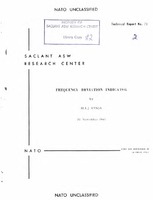| dc.description.abstract | A new type of discriminator was developed to measure the frequency variation of electrical signals; it has the special feature to indicate without any delay the difference between the signal frequency and some fixed reference frequency. The discriminator consists of two different parallel, frequency sensitive, networks, the outputs on which are always either in phase or in phase opposition but have different amplitudes. On a CRT screen these two voltages produce a line; the length of the line gives the amplitude and its direction gives the frequency of the original signal. By a proper choice of some circuit parameters, the indication can be made linear with the frequency within a relatively large frequency band. Between the limits of noise and overload of the amplifiers, the signal amplitude has no influence on the indicated angle. The same networks can be used to construct a simple discriminator that produces a DC voltage proportional to the frequency deviation as is done by FM demodulator circuits. Among the many applications of this discriminator this report describes the registration of the changes in the earth's magnetic field with the use of a Rubidium Vapour Magnetometer and the recording of the variations in the sound velocity in sea water using a Daystrom Sound Velocity Meter. | |
